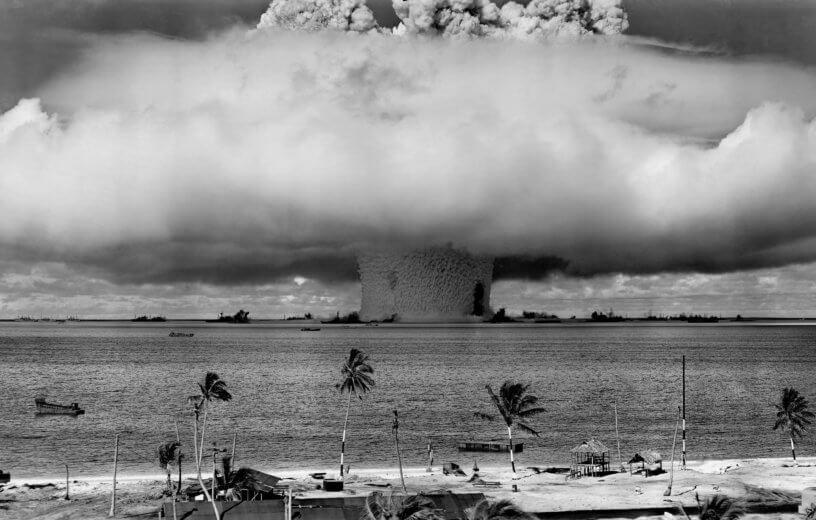HOBOKEN, N. J. — Long gone are the days of the Cold War in which American children were routinely drilled on what to do in the event of a nuclear attack. All these years later, the threat of a nuclear weapon striking U.S. soil is still a possibility, albeit one that isn’t discussed all that often as a real threat. However, countless movies, video games, and other pieces of pop culture have explored the apocalyptic results such an attack would produce, so it wouldn’t be accurate to say that nuclear weapons aren’t somewhat ingrained in our national consciousness. Still, the findings of a new study performed at Stevens Institute of Technology are quite startling when it comes to Americans’ fears and beliefs over a possible nuclear war.
After surveying more than 3,500 Americans, researchers concluded that the average U.S. citizen perceives the current odds of a nuclear attack on U.S. soil at 50%, or essentially coming down to a coin toss. “That’s exceptionally high,” says study author Kristyn Karl, a political scientist at Stevens, in a release. “People don’t generally believe that highly rare events are slightly less likely than a 50/50 tossup.”
Despite this unusually high statistic, the study’s authors also noted that many Americans aren’t inclined to seek out information on nuclear weapons, or prepare for an attack, even if they believe such an event is a possibility.
Using two nationally diverse online surveys, researchers asked participants about their feelings towards nuclear weapons in general, the likelihood of an attack on America, overall media use, and their level of interest in following current events. The research also delved into how these feelings toward nuclear weapons may influence people’s actions (seeking out information, talking to others about their fear, or preparing emergency kits).
Ultimately, the research team are hoping their work, which is part of a larger initiative called the Reinventing Civil Defense Project, can help develop new communication methods to keep a new generation of Americans informed when it comes to nuclear weapons, and in a worse case scenario, actions to take in the event of a legitimate attack.
“The overarching narrative from the Reinventing Civil Defense project is that younger Americans just don’t hear anything about nuclear weapons risk,” comments Karl. “Unlike older Americans, Millennials and Gen Z didn’t grow up during the Cold War, so what they know about nuclear risk is what’s in the media, and what’s in the media isn’t necessarily reflective of the true state of affairs.”
The study’s authors noted that younger adults who consume a lot of media tend to be more apathetic towards nuclear topics, and rarely seek out information on the subject. On the other hand, there didn’t seem to be any connection between older adults’ media habits and their interest in nuclear weapons.
Additionally, it was also observed that as the average American grows older, they tend to spend less and less time worrying about nuclear weapons.
“Among lots of possibilities, they may be thinking if it didn’t happen during the Cold War, it won’t happen now; or perhaps I have fewer years to live, so it probably won’t happen in my lifetime,” explains co-author and psychologist Ashley Lytle.
City dwellers are a bit more on edge about nuclear risks, with the average urban resident estimating the chances of a nuclear attack being 5-7% higher than the average rural resident. Furthermore, women estimate the risk of a nuclear attack in the U.S. as 3-5% higher than men.
One prevailing notion among respondents was that of helplessness, and subsequent inaction. The general idea being, “If a nuclear bomb were to go off in my city I would surely die, so why waste any time trying to prepare?”
While a detonation in a heavily populated area would undoubtedly result in thousands of casualties, researchers say it really isn’t as simple as assuming everyone will die. There are a number of factors that could influence the reach of such an explosion, including the size of the bomb, weather, and exact location of detonation. Predictive models of nuclear explosions in large cities have suggested that much of the blast would be funneled upward by tall buildings, increasing many people’s chances of survival.
If this were to happen, researchers say the best course of action would be to get inside a building that’s still intact and stay inside for three days.
“Our gut reaction is that everybody would die. But not everybody,” Lytle comments. “We are trying to figure out how to educate people that this is not always true so that people feel like they have some sort of agency in a situation like this. Many people could survive the initial blast and then their subsequent behavior would determine what happens from there.”
To be clear, the study’s authors aren’t trying to make any sensational claims that a nuclear attack is imminent. That being said, while Americans seem to be at least aware of the possibility of a nuclear strike, many seem disinclined to seek out information or try to prepare at all. The research team hope their work can help change that, as just a few small tips on what to do could end up saving countless lives.
The study is published in the International Journal of Communication.
